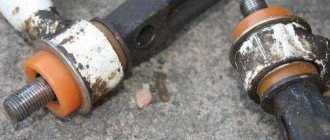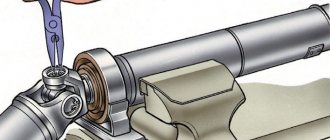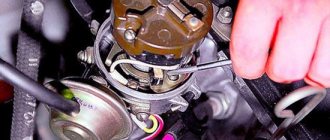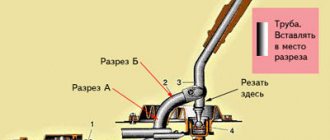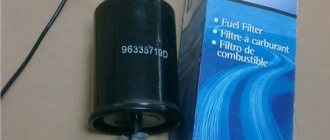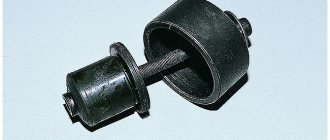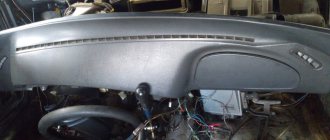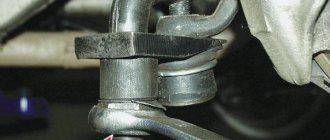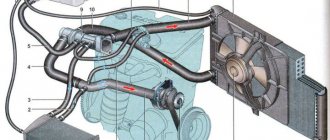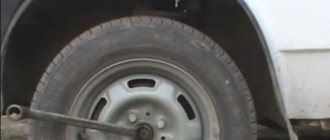Silent blocks are elements of a car's suspension, consisting of two metal bushings separated by a rubber or polyurethane insert, designed to make the car's movement more comfortable and reduce noise when driving. These parts are installed in the moving parts of the suspension, and they are constantly exposed to mechanical stress. In VAZ 2101-2107, the front silent blocks most often suffer under loads, and the problem can be solved independently, without resorting to the use of special tools and the services of service station technicians.
Silent blocks VAZ 2107
On the Internet, the specifics of replacing the silent blocks of the suspension of the VAZ 2107 and other cars of the domestic and foreign automobile industry are often discussed. The problem is actually urgent and is due to the poor quality of our roads. Since the silent block is one of the important elements of the vehicle suspension design, special attention must be paid to its selection and replacement.
Silent blocks are designed to dampen vibrations that are transmitted from one suspension unit to another
What are silent blocks
The silent block (hinge) structurally consists of two metal bushings connected to each other by a rubber insert. The part is designed to connect suspension elements, and the presence of rubber allows you to dampen vibrations that are transmitted from one unit to another. The silent block must perceive and endure all deformations to which the car suspension is subjected.
Where are they installed?
On the VAZ "Seven" silent blocks are installed in the front and rear suspension. At the front, levers are attached using this part, and at the rear, reaction rods (longitudinal and transverse) connect the axle to the body. To ensure that the car's suspension is always in good condition and handling does not deteriorate, you need to monitor the condition of the silent blocks and replace them in a timely manner.
The front suspension of the classic Zhiguli consists of the following parts: 1. Spar. 2. Stabilizer bracket. 3. Rubber cushion. 4. Stabilizer bar. 5. Lower arm axis. 6. Lower suspension arm. 7. Hairpin. 8. Lower arm amplifier. 9. Stabilizer bracket. 10. Stabilizer clamp. 11. Shock absorber. 12. Bracket bolt. 13. Shock absorber bolt. 14. Shock absorber bracket. 15. Suspension spring. 16. Steering knuckle. 17. Ball joint bolt. 18. Elastic liner. 19. Cork. 20. Insert clip. 21. Bearing housing. 22. Ball bearing. 23. Protective cover. 24. Lower ball pin. 25. Self-locking nut. 26. Finger. 27. Spherical washer. 28. Elastic liner. 29. Pressure ring. 30. Insert clip. 31. Bearing housing. 32. Bearing. 33. Upper suspension arm. 34. Upper arm amplifier. 35. Compression progress buffer. 36. Buffer bracket. 37. Support cap. 38. Rubber cushion. 39. Nut. 40. Belleville washer. 41. Rubber gasket. 42. Spring support cup. 43. Upper arm axis. 44. Inner bushing of the hinge. 45. Outer bushing of the hinge. 46. Rubber bushing of the hinge. 47. Thrust washer. 48. Self-locking nut. 49. Adjusting washer 0.5 mm 50. Distance washer 3 mm. 51. Cross member. 52. Inner washer. 53. Inner sleeve. 54. Rubber bushing. 55. Outer thrust washer
What types of silent blocks are there?
In addition to the purpose of silent blocks, you need to know that these products can be made of rubber or polyurethane. It is generally accepted that replacing rubber suspension components with polyurethane ones, where possible, will only improve the characteristics and performance of the suspension.
Silent blocks made of polyurethane are characterized by a longer service life, unlike rubber ones.
The disadvantage of polyurethane elements is their high cost - they are about 5 times more expensive than rubber ones. When installing polyurethane products on a VAZ 2107, you can improve the car's behavior on the road, reduce deformations in the suspension, and also eliminate the so-called squeezing, which is characteristic of rubber elements. This means that the suspension will operate in the condition intended by the designers at the factory. With the correct selection and installation of polyurethane parts, noise and vibration are reduced and shocks are absorbed, which indicates the better performance of such hinges compared to rubber ones.
Silent blocks made of polyurethane are considered more reliable than rubber ones, but are much more expensive
Reasons for failure
When encountering failures of silent blocks for the first time, it is quite difficult to imagine what can happen to these products after long-term use. Over time, the rubber begins to tear, resulting in the need to replace the hinge. There may be several reasons why a product becomes unusable:
- High mileage of the car, the consequence of which was the drying out of the rubber, loss of its elasticity and the appearance of cracks and tears.
- Contact of chemicals with the rubber of the silent block. Since the suspension element in question is located near the engine, it is likely that it will be exposed to oil, which leads to the destruction of the rubber.
- Incorrect installation. Fastening the bolts of the levers should only be done after the car is installed on the wheels and not hung on a lift. If tightened incorrectly, the rubber of the silent block becomes strongly twisted, which leads to rapid failure of the product.
Checking status
It would be a good idea for the owners of the “Seven” to know how to determine that the silent blocks need to be replaced. High-quality products last for quite a long time - up to 100 thousand km. However, due to the condition of our roads, the need to replace them usually arises after 50 thousand km. You can determine that the rubber joints have become unusable by how you feel while driving the car. If the car begins to handle worse, the steering wheel is no longer as responsive as before, then this indicates obvious wear and tear on the silent blocks. To be more confident, it is recommended to visit a service station so that specialists can diagnose the suspension.
If visible signs of wear appear, the part needs to be replaced.
The condition of silent blocks can be determined independently by visual inspection. To do this, you will need to drive the car onto an overpass or inspection hole, and then inspect each of the hinges. The rubber part should not have cracks or tears. One of the signs of failure of silent blocks is a violation of wheel alignment. In addition, a sign of wear on the part in question is uneven wear on the tire tread. This phenomenon indicates an incorrectly adjusted wheel alignment, which may be causing the vehicle's suspension to malfunction.
There is no point in delaying the replacement of silent blocks, since over time the seats in the levers become broken, so the lever assembly may need to be replaced.
Video: diagnostics of silent blocks
Replacing silent blocks in the upper control arm of a classic with your own hands.
So, let's begin! In rear-wheel drive VAZs, the silent blocks in the upper arm can be changed without even driving into a hole and without removing the arm from the ball (provided that you have a remover for silent blocks). But first you need to determine whether the bushings of the silent blocks are stuck to the bolt securing the lever to the body. To do this, jack up the car and remove the wheel.
Arrows point to bolt and nut
We loosen the nut securing the upper arm with a 22mm wrench and try to turn the bolt. If it spins and the bushings stay in place, then you're in luck! But if this bolt rotates with great force and the bushings rotate with them, then as they say: “Houston, we have problems!” Next we will consider both cases.
If the silent blocks are not stuck.
Further actions depend on whether you have a puller for silent blocks. If there is one, then you don’t have to remove the lever completely, but just unscrew the nut 22 to the end, take out the bolt and turn the lever towards yourself (for the convenience of further repairs).
We turn the lever for convenience.
Next, take a puller and press out the silent blocks.
Removing the silent block using a puller
And with his help we press in new silent blocks. Before pressing, the mounting hole must be cleaned and preferably lubricated with lithol. In the upper arms, silent blocks are pressed into place up to the ribs, as shown in the photo below.
The new silent should be pressed in exactly like this.
But what to do if you don’t have a silent block remover ? Then you will have to completely remove the lever. We take out not only the bolt securing the upper arm to the body, but also take out the ball from the hub (this is faster than unscrewing 3 bolts securing the ball to the arm). Detailed removal of the ball joint is written here.
We removed the lever, put the lever ear on a pipe or on a yew tree (as in the photo), the main thing is that the silent block does not rest against anything, and knock it out with a hammer.
To press in new ones, we need a mandrel (old bearing, piece of pipe, nut head). The inner diameter of the mandrel must be equal to the diameter of the skirt of the new silent block. And we begin pressing in new parts using this mandrel, having previously lubricated the seat with lithol. Reassemble in reverse order.
Important: we pull the bolt securing the lever to the body only under the load on this wheel! Those. The car should not be on a jack, but on all wheels!
If the silent blocks are stuck to the bolt.
This is a very difficult case, since you will have to spend a long time trying to get the bolt that secures the front upper arm to the body.
For those who want to save themselves a lot of time and are ready to fork out a little, I advise you to buy a new bolt, this lever from disassembly and just cut off the old bolt with a grinder.
Well, if you have time and nerves, then we take a gas burner in our hands and burn out the silent block. Follow fire safety precautions! After all the rubber has burned out, you can begin to knock out the bolt. Get ready to do this for a very long time. After you remove the bolt, knock out the remaining clip of the burnt silent tape from the lever and follow the instructions written above.
A little theory
The silent block is one of the critical parts of the suspension of the VAZ-2106 car, with the help of which fastening elements of such units as:
- shock absorbers;
- anti-roll bar;
- gear box;
- jet thrust;
- beam supports;
- rear suspension rods.
Despite the apparent simplicity of the design, the rubber-metal hinge in the VAZ-2106:
- ensures the mobility of suspension parts relative to each other;
- withstands axial, radial and angular loads;
- absorbs vibrations simultaneously in all planes.
FakeHeader
Comments 7
Hello. Two years have passed. I just came across your story. Now I was tightening the upper silent blocks, the rubber bands on the outside stupidly came out from under the washers. And I didn’t make it to 60. I’m sitting here scratching my turnips. True, my graphics are blurry. But the lower ones were also lubricated, they were tightened for 80 minutes and did not come out.
Hello! Thank you for remembering) The range is 60-90 N*m because our rubber products are produced according to specifications. It’s not clear to anyone what specifications a particular manufacturer has. You shouldn’t pinch the rubber bands—that’s a fact. My silent blocks drove for 3000, then I swapped them as is with levers onto a friend’s car, tightened them by eye - and it’s still running.
In addition, if you go to a good service center for wheel alignment, they will tighten the wheel alignment there. properly, because the nuts will be unscrewed.
If I understand correctly, did you tighten the silent blocks on the unassembled suspension? You only need to tighten the silent block nuts (!) when everything is already assembled, the wheel is in place and the car is lowered to the ground. When you tighten the nuts, the levers should be in the position they are always in when the car is at rest. Otherwise the silent blocks will die very quickly.
Thank you. Based on the experience of repairing Lada cars, what is the conclusion? The lever will tilt down during assembly, the silent block relative to the mudguard and the bolt are the same, no matter how you look at it, and somehow I didn’t think about what you said. Anyway, before replacing the lower ones I wanted to check
In the design of a car suspension, the connection of some components with each other to the load-bearing part (body) is carried out using rubber-metal hinges - silent blocks. The main task of these rubber products is to dampen vibration and prevent its transmission between suspension elements.
The silent block is an important element of the suspension design, but at the same time it is also its weak link.
The presence of a rubber component in its design makes this element not particularly durable. In addition, it is subject to repair, which classifies these hinges into the category of consumables, which, after exhausting their service life, are simply replaced.
Security measures
When performing repair work, do not forget about basic safety measures:
- Before hanging on a jack, the car is placed on the handbrake, and wheel chocks are placed under the wheels;
- In parallel with the jack, a safety support is installed under the body of the suspended car;
- When working with a hammer, for example, pressing a ball joint out of a bipod, use safety glasses;
- Wear gloves to protect your hands from damage if the wrench may slip off the nut.
Diagnostics of rubber-metal joints
To check the condition of silent blocks, you need to use a pit or overpass. Without such amenities, it will be problematic to drive the seven, so there should be a pit in every garage. therefore, it can be repaired by hand without any problems. But you need to determine whether the VAZ-2107 silent blocks need to be replaced; the price of one is approximately 50 rubles. For a set of 8 silent blocks you will pay 400 rubles.
Carefully inspect the suspension on the lever, evaluate the appearance of the rubber-metal hinge. If the rubber has obvious damage - it has begun to become cracked, or there are any cuts at all, then all elements must be replaced. When carrying out repairs, try to do as much work as possible. Therefore, you not only change all eight silent blocks, but also, after assessing the condition of the balls, replace them if necessary. It is also worth looking at the condition and tightening the nut if necessary.
Tools and spare parts
In order to replace silent blocks on a VAZ-2106 car with your own hands, you need a set of appropriate tools. These include:
- Set of devices (pullers) for:
- removing the upper arm;
- dismantling steering tips;
- removing and installing hinges.
- Jack.
- A set of wrenches (socket, open-end, socket).
- Chisel.
- Mounting blade.
- Hammer.
- Mount.
- Soap solution.
In order to replace worn parts, you need to have on hand:
- a set of new silent blocks for VAZ 2101 - VAZ2107 cars;
- new fasteners (bolts, nuts, axles, etc.).
What is a silent block and why is replacement needed?
A silent block is an element of a car suspension, which is designed to connect the levers to the car body or frame in order to reduce wear of metal parts during friction. It consists of two bushings made of metal, between which there is a rubber insert. This insert can also be made of polyurethane, which is why the term “polyurethane silent block” is often used. In addition to the suspension, this part is also used to attach shock absorbers, the car’s gearbox, and many other parts subject to vibration and swaying.
The replacement of silent blocks by the manufacturer is prescribed every 100 thousand kilometers, however, knowing the state of Russian roads, it is better to carry out such a procedure every 50 thousand kilometers. In addition, in addition to the mileage, you can assess the condition of the silent blocks by knocking in the suspension on large road irregularities and external signs:
- the appearance of gaps in places where silent blocks are installed;
- the presence of cracks in the rubber, which indicate its imminent rupture;
- hinge damage;
- uneven wear of wheel rubber (usually, uneven wear occurs due to incorrectly adjusted wheel alignment, but a silent block that is in unsatisfactory condition also plays a very important role in the uniform alignment of the wheels on the road surface);
The reasons why this part becomes unusable are aggressive driving style and poor-quality road surface.
When silent blocks wear out, the car may behave unevenly on the road, which can easily cause an accident. That is why timely replacement of this suspension element is so important.
